Vegetation Properties in Human-Impacted Riparian Zones Based on Unmanned Aerial Vehicle (UAV) Imagery: An Analysis of River Reaches in the Yongding River Basin
Abstract
1. Introduction
2. Materials and Methods
2.1. Study Site
2.2. Data Collection
2.3. Data Process
3. Results
3.1. Distribution of Plant Life Forms in the Riparian Zone
3.2. The Vegetation Coverage in the Riparian Zone
4. Discussion
5. Conclusions
Supplementary Materials
Author Contributions
Funding
Institutional Review Board Statement
Informed Consent Statement
Data Availability Statement
Acknowledgments
Conflicts of Interest
References
- And, R.J.N.; Décamps, H. The Ecology of Interfaces: Riparian Zones. Annu. Rev. Ecol. Syst. 1997, 28, 621–658. [Google Scholar] [CrossRef]
- Woodley, E. Building Nigeria’s Response to Climate Change: Pilot Projects for Community-Based Adaptation in Nigeria. Clim. Chang. Manag. 2011, 20, 297–315. [Google Scholar] [CrossRef]
- Wang, X.; Wang, Q.; Yang, S.; Zheng, D.; Wu, C.; Mannaerts, C. Evaluating nitrogen removal by vegetation uptake using satellite image time series in riparian catchments. Sci. Total. Environ. 2011, 409, 2567–2576. [Google Scholar] [CrossRef] [PubMed]
- Klein, L.R.; Hendrix, W.G.; Lohr, V.I.; Kaytes, J.B.; Sayler, R.D.; Swanson, M.E.; Elliot, W.J.; Reganold, J.P. Linking ecology and aesthetics in sustainable agricultural landscapes: Lessons from the Palouse region of Washington, U.S.A. Landsc. Urban Plan. 2015, 134, 195–209. [Google Scholar] [CrossRef]
- Vollmer, D.; Prescott, M.F.; Padawangi, R.; Girot, C.; Grêt-Regamey, A. Understanding the value of urban riparian corridors: Considerations in planning for cultural services along an Indonesian river. Landsc. Urban Plan. 2015, 138, 144–154. [Google Scholar] [CrossRef]
- Zaimes, G.N.; Gounaridis, D.; Symenonakis, E. Assessing the impact of dams on riparian and deltaic vegetation using remotely-sensed vegetation indices and Random Forests modelling. Ecol. Indic. 2019, 103, 630–641. [Google Scholar] [CrossRef]
- Zahar, Y.; Ghorbel, A.; Albergel, J. Impacts of large dams on downstream flow conditions of rivers: Aggradation and reduction of the Medjerda channel capacity downstream of the Sidi Salem dam (Tunisia). J. Hydrol. 2008, 351, 318–330. [Google Scholar] [CrossRef]
- Arnold, J.F. Plant Life-Form Classification and Its Use in Evaluating Range Conditions and Trend. J. Range Manag. 2007, 8, 176. [Google Scholar] [CrossRef]
- Bejarano, M.D.; Sarneel, J.M.; Su, X.; Bejarano, M.D. Shifts in Riparian Plant Life Forms Following Flow Regulation. Forests 2020, 11, 518. [Google Scholar] [CrossRef]
- Bhattarai, K.R.; Vetaas, O.R. Variation in plant species richness of different life forms along a subtropical elevation gradient in the Himalayas, east Nepal. Glob. Ecol. Biogeogr. 2003, 12, 327–340. [Google Scholar] [CrossRef]
- Marini, L.; Battisti, A.; Bona, E.; Federici, G.; Martini, F.; Pautasso, M.; Hulme, P.E. Alien and native plant life-forms respond differently to human and climate pressures. Glob. Ecol. Biogeogr. 2011, 21, 534–544. [Google Scholar] [CrossRef]
- Casillo, J.; Kunst, C.; Semmartin, M. Effects of fire and water availability on the emergence and recruitment of grasses, forbs and woody species in a semiarid Chaco savanna. Austral Ecol. 2012, 37, 452–459. [Google Scholar] [CrossRef]
- Gutman, G.; Ignatov, A. The derivation of the green vegetation fraction from NOAA/AVHRR data for use in numerical weather prediction models. Int. J. Remote. Sens. 1998, 19, 1533–1543. [Google Scholar] [CrossRef]
- Wang, X.; Jia, K.; Liang, S.; Li, Q.; Wei, X.; Yao, Y.; Zhang, X.; Tu, Y. Estimating Fractional Vegetation Cover From Landsat-7 ETM+ Reflectance Data Based on a Coupled Radiative Transfer and Crop Growth Model. IEEE Trans. Geosci. Remote. Sens. 2017, 55, 5539–5546. [Google Scholar] [CrossRef]
- Pyke, D.; Herrick, J.; Shaver, P.; Pellant, M. Rangeland health attributes and indicators for qualitative assessment. J. Range Manag. 2006, 55, 584–597. [Google Scholar] [CrossRef]
- Gibbons, P.; Freudenberger, D. An overview of methods used to assess vegetation condition at the scale of the site. Ecol. Manag. Restor. 2006, 7, S10–S17. [Google Scholar] [CrossRef]
- Burdon, F.J.; Ramberg, E.; Sargac, J.; Forio, M.A.E.; De Saeyer, N.; Mutinova, P.T.; Moe, T.F.; Pavelescu, M.O.; Dinu, V.; Cazacu, C.; et al. Assessing the Benefits of Forested Riparian Zones: A Qualitative Index of Riparian Integrity Is Positively Associated with Ecological Status in European Streams. Water 2020, 12, 1178. [Google Scholar] [CrossRef]
- Garófano-Gómez, V.; Martínez-Capel, F.; Bertoldi, W.; Gurnell, A.; Estornell, J.; Segura-Beltrán, F. Six decades of changes in the riparian corridor of a Mediterranean river: A synthetic analysis based on historical data sources. Ecohydrology 2012, 6, 536–553. [Google Scholar] [CrossRef]
- Marcus, W.A.; Fonstad, M.A. Optical remote mapping of rivers at sub-meter resolutions and watershed extents. Earth Surf. Process. Landforms 2007, 33, 4–24. [Google Scholar] [CrossRef]
- Palmquist, E.C.; Ralston, B.E.; Merritt, D.M.; Shafroth, P.B. Landscape-scale processes influence riparian plant composition along a regulated river. J. Arid. Environ. 2018, 148, 54–64. [Google Scholar] [CrossRef]
- Johansen, K.; Phinn, S.R.; Witte, C. Mapping of riparian zone attributes using discrete return LiDAR, QuickBird and SPOT-5 imagery: Assessing accuracy and costs. Remote. Sens. Environ. 2010, 114, 2679–2691. [Google Scholar] [CrossRef]
- Gergel, E.S.; Stange, Y.; Coops, N.; Johansen, K.; Kirby, K.R. What is the Value of a Good Map? An Example Using High Spatial Resolution Imagery to Aid Riparian Restoration. Ecosystems 2007, 10, 688–702. [Google Scholar] [CrossRef]
- Claggett, P.R.; Okay, J.A.; Stehman, S.V. Monitoring Regional Riparian Forest Cover Change Using Stratified Sampling and Multiresolution Imagery1. JAWRA J. Am. Water Resour. Assoc. 2010, 46, 334–343. [Google Scholar] [CrossRef]
- Fullerton, A.H.; Beechie, T.J.; Baker, S.E.; Hall, J.E.; Barnas, K.A. Regional patterns of riparian characteristics in the interior Columbia River basin, Northwestern USA: Applications for restoration planning. Landsc. Ecol. 2006, 21, 1347–1360. [Google Scholar] [CrossRef]
- Matsuura, T.; Suzuki, W. Analysis of topography and vegetation distribution using a digital elevation model: Case study of a snowy mountain basin in northeastern Japan. Landsc. Ecol. Eng. 2012, 9, 143–155. [Google Scholar] [CrossRef]
- Riedler, B.; Pernkopf, L.; Strasser, T.; Lang, S.; Smith, G. A composite indicator for assessing habitat quality of riparian forests derived from Earth observation data. Int. J. Appl. Earth Obs. Geoinf. 2015, 37, 114–123. [Google Scholar] [CrossRef]
- Tompalski, P.; Coops, N.C.; White, J.C.; Wulder, M.A.; Yuill, A. Characterizing streams and riparian areas with airborne laser scanning data. Remote. Sens. Environ. 2017, 192, 73–86. [Google Scholar] [CrossRef]
- Solins, J.P.; Thorne, J.H.; Cadenasso, M.L. Riparian canopy expansion in an urban landscape: Multiple drivers of vegetation change along headwater streams near Sacramento, California. Landsc. Urban Plan. 2018, 172, 37–46. [Google Scholar] [CrossRef]
- Huylenbroeck, L.; Laslier, M.; Dufour, S.; Georges, B.; Lejeune, P.; Michez, A. Using remote sensing to characterize riparian vegetation: A review of available tools and perspectives for managers. J. Environ. Manag. 2020, 267, 110652. [Google Scholar] [CrossRef]
- Michez, A.; Piégay, H.; Lisein, J.; Claessens, H.; Lejeune, P. Classification of riparian forest species and health condition using multi-temporal and hyperspatial imagery from unmanned aerial system. Environ. Monit. Assess. 2016, 188, 1–19. [Google Scholar] [CrossRef]
- Dunford, R.; Michel, K.; Gagnage, M.; Piégay, H.; Trémelo, M.-L. Potential and constraints of Unmanned Aerial Vehicle technology for the characterization of Mediterranean riparian forest. Int. J. Remote. Sens. 2009, 30, 4915–4935. [Google Scholar] [CrossRef]
- Michez, A.; Piégay, H.; Jonathan, L.; Claessens, H.; Lejeune, P. Mapping of riparian invasive species with supervised classification of Unmanned Aerial System (UAS) imagery. Int. J. Appl. Earth Obs. Geoinf. 2016, 44, 88–94. [Google Scholar] [CrossRef]
- Vasekova, B.; Nemetova, Z.; Keszeliova, A.; Stefunkova, Z. Mapping Invasive Plants in Riverbank Vegetation. IOP Conf. Ser. 2019, 221, 012109. [Google Scholar] [CrossRef]
- Colomina, I.; Molina, P. Unmanned aerial systems for photogrammetry and remote sensing: A review. ISPRS J. Photogramm. Remote. Sens. 2014, 92, 79–97. [Google Scholar] [CrossRef]
- Jiang, B.; Wong, C.P.; Lu, F.; Ouyang, Z.; Wang, Y. Drivers of drying on the Yongding River in Beijing. J. Hydrol. 2014, 519, 69–79. [Google Scholar] [CrossRef]
- Dai, D.; Xu, X.; Sun, M.; Hao, C.; Lv, X.; Lei, K. Decrease of both river flow and quality aggravates water crisis in North China: A typical example of the upper Yongding River watershed. Environ. Monit. Assess. 2020, 192, 1–13. [Google Scholar] [CrossRef]
- Romeo, F.V.; Piscopo, A.; Poiana, M. Effect of drying, chemical and natural processing methods on black Biancolilla olives. Grasas Aceites 2012, 63, 223–230. [Google Scholar] [CrossRef][Green Version]
- Wu, B.; Feng, Z.K.; Wei, X.H.; Wang, C.B.; Wang, Y.G. Change of land use and landscape pattern in Yongding River Watershed. For. Inventory. Plan. 2011, 36, 30–34. [Google Scholar]
- Zhao, Y.L.; Gong, Z.N. Analysis of land cover change and its driving force in downstream of Yongding River. J. Nat. Disasters. 2012, 21, 63–71. [Google Scholar]
- Jia, W.J.; Wei, X.H.; Wang, X.L.; Feng, Z.K. Research on Beijing Yongding River Basin Forest Vegetation Coverage Changes. For. Inventory. Plan. 2011, 36, 22–25. [Google Scholar]
- Xiu, C.; Zheng, H.; Ouyang, Z.Y. Flora analysis of riparian vegetation in Yongding-Haihe river system, China. Acta. Ecol. Sin. 2014, 34, 1535–1547. [Google Scholar]
- Huifen, L.; Fang, M.; Chengming, Y. Estimation of Vegetation Fractional Coverage in Lugu Lake Based on the Dimidiate Pixel Model. In Proceedings of the 2013 Fifth International Conference on Measuring Technology and Mechatronics Automation, Hong Kong, China, 16–17 January 2013; pp. 532–535. [Google Scholar] [CrossRef]
- Garssen, A.G.; Baattrup-Pedersen, A.; Voesenek, L.A.C.J.; Verhoeven, J.T.A.; Soons, M.B. Riparian plant community responses to increased flooding: A meta-analysis. Glob. Chang. Biol. 2015, 21, 2881–2890. [Google Scholar] [CrossRef] [PubMed]
- Sarneel, J.M.; Bejarano, M.D.; Van Oosterhout, M.; Nilsson, C. Local flooding history affects plant recruitment in riparian zones. J. Veg. Sci. 2019, 30, 224–234. [Google Scholar] [CrossRef]
- Aguiar, F.C.; Segurado, P.; Martins, M.J.; Bejarano, M.D.; Nilsson, C.; Portela, M.M.; Merritt, D.M. The abundance and distribution of guilds of riparian woody plants change in response to land use and flow regulation. J. Appl. Ecol. 2018, 55, 2227–2240. [Google Scholar] [CrossRef]
- Fu, B.; Burgher, I. Riparian vegetation NDVI dynamics and its relationship with climate, surface water and groundwater. J. Arid. Environ. 2015, 113, 59–68. [Google Scholar] [CrossRef]
- Chen, Y.; Chen, Y.; Xu, C.; Ye, Z.; Li, Z.; Zhu, C.; Ma, X. Effects of ecological water conveyance on groundwater dynamics and riparian vegetation in the lower reaches of Tarim River, China. Hydrol. Process. 2009, 24, 170–177. [Google Scholar] [CrossRef]
- Zermeño-Hernández, I.; Benítez-Malvido, J.; Suazo-Ortuño, I.; Méndez-Toribio, M. Impact of adjacent land use on the ecological condition of riparian habitats: The relation between condition and vegetation properties. Appl. Veg. Sci. 2020, 23, 610–621. [Google Scholar] [CrossRef]
- Amy, J.; Robertson, A.I. Relationships between livestock management and the ecological condition of riparian habitats along an Australian floodplain river. J. Appl. Ecol. 2001, 38, 63–75. [Google Scholar] [CrossRef]
- Breckenridge, R.P.; Dakins, M.; Bunting, S.; Harbour, J.L.; Lee, R.D. Using Unmanned Helicopters to Assess Vegetation Cover in Sagebrush Steppe Ecosystems. Rangel. Ecol. Manag. 2012, 65, 362–370. [Google Scholar] [CrossRef]
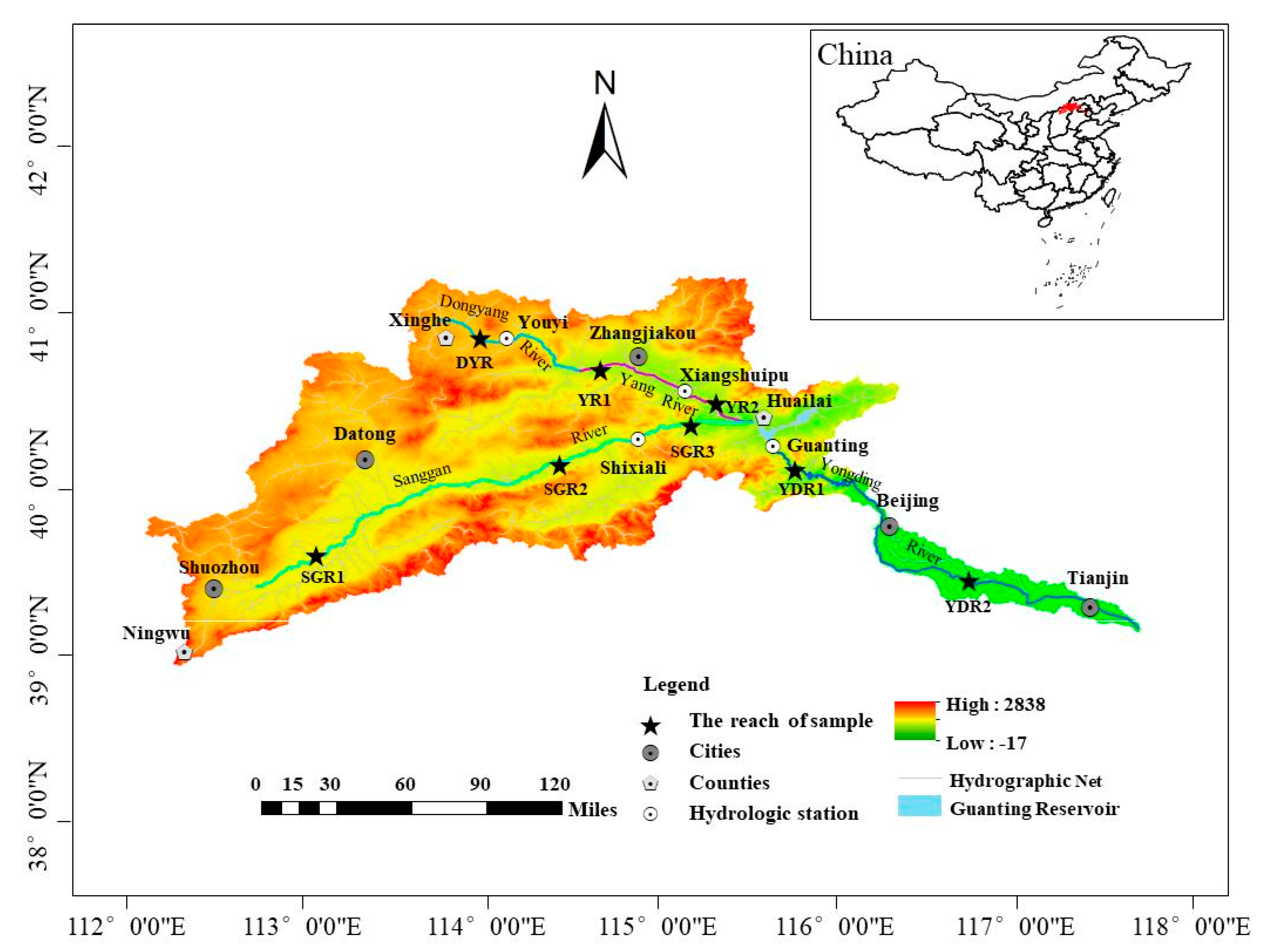
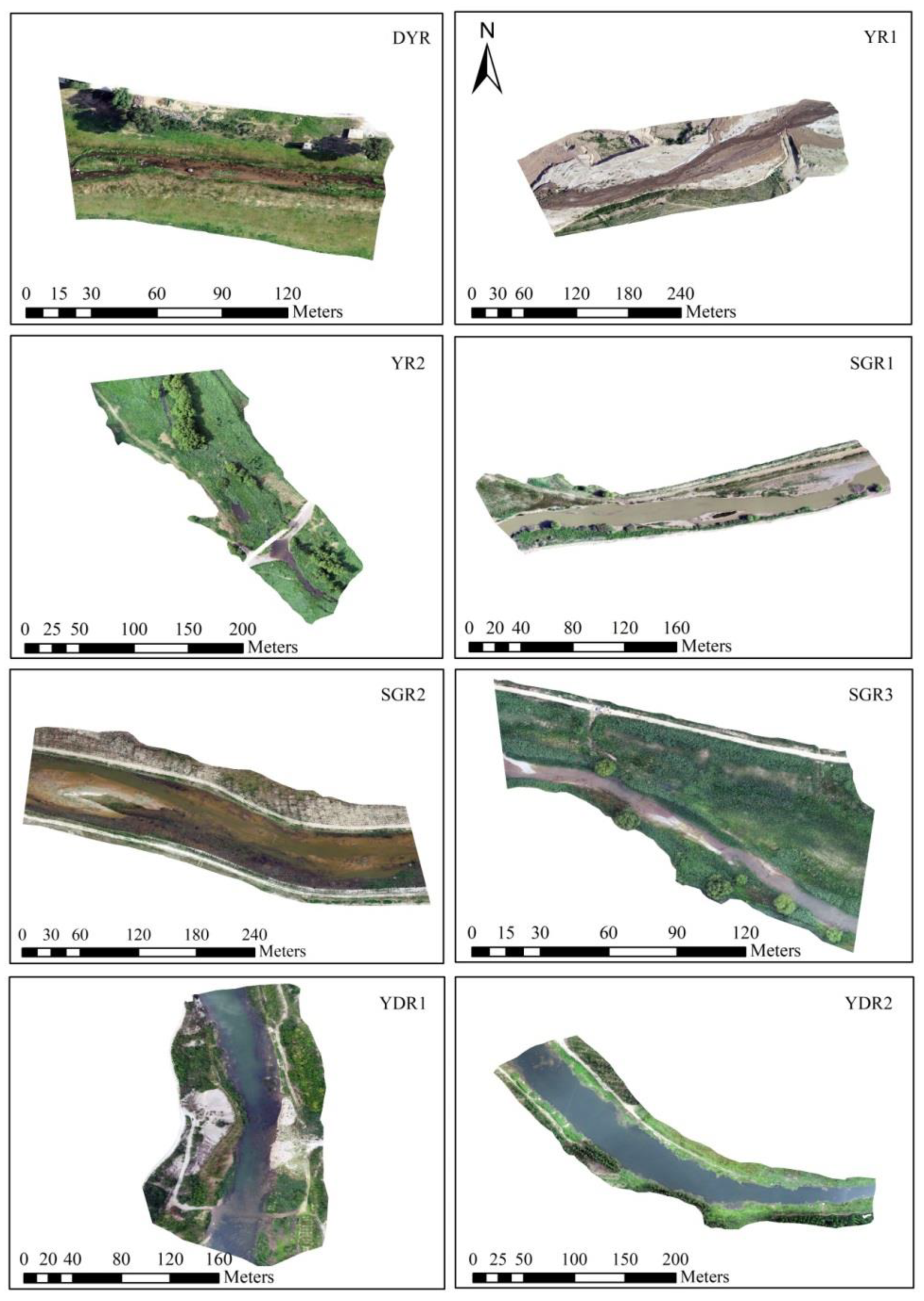
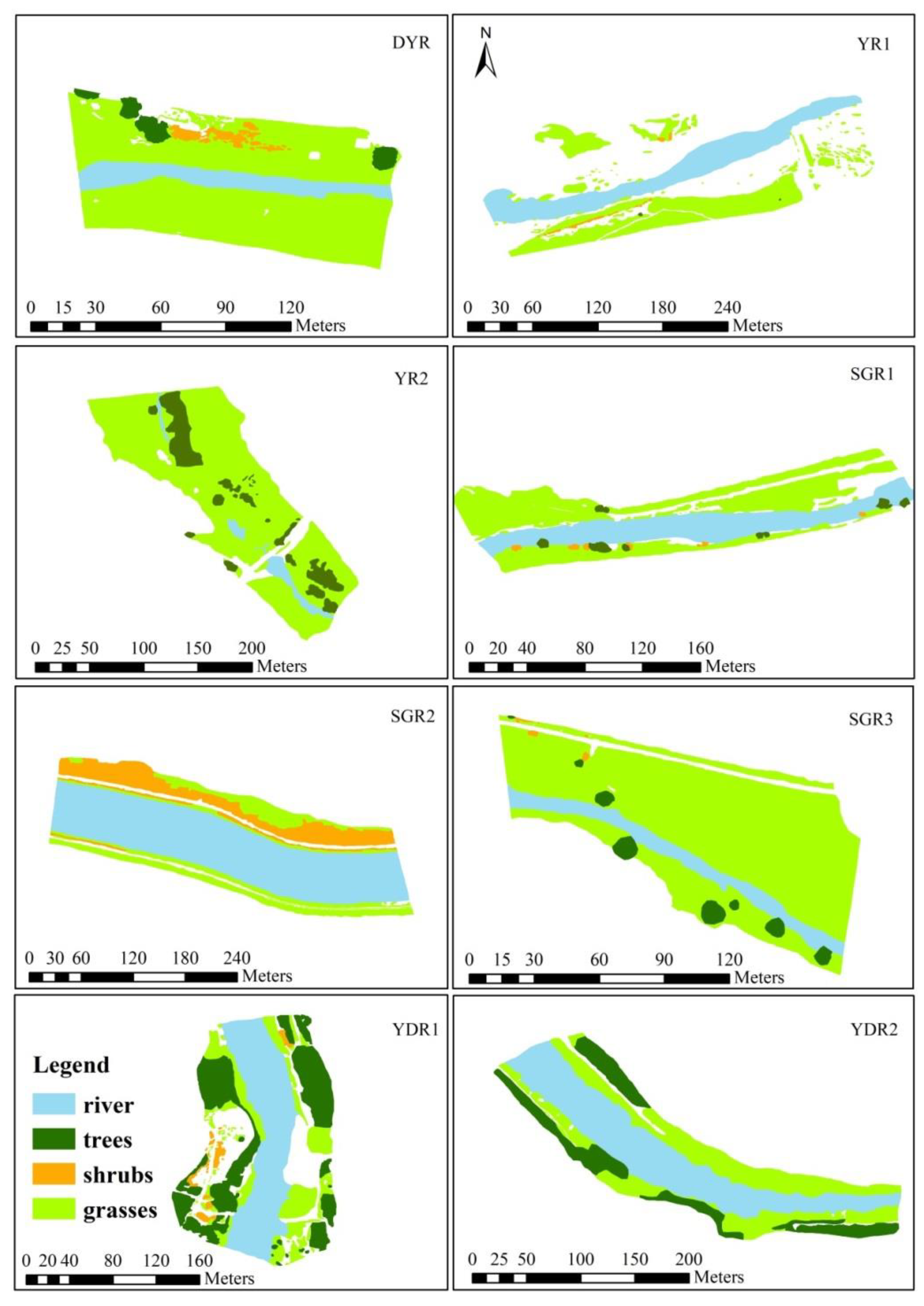
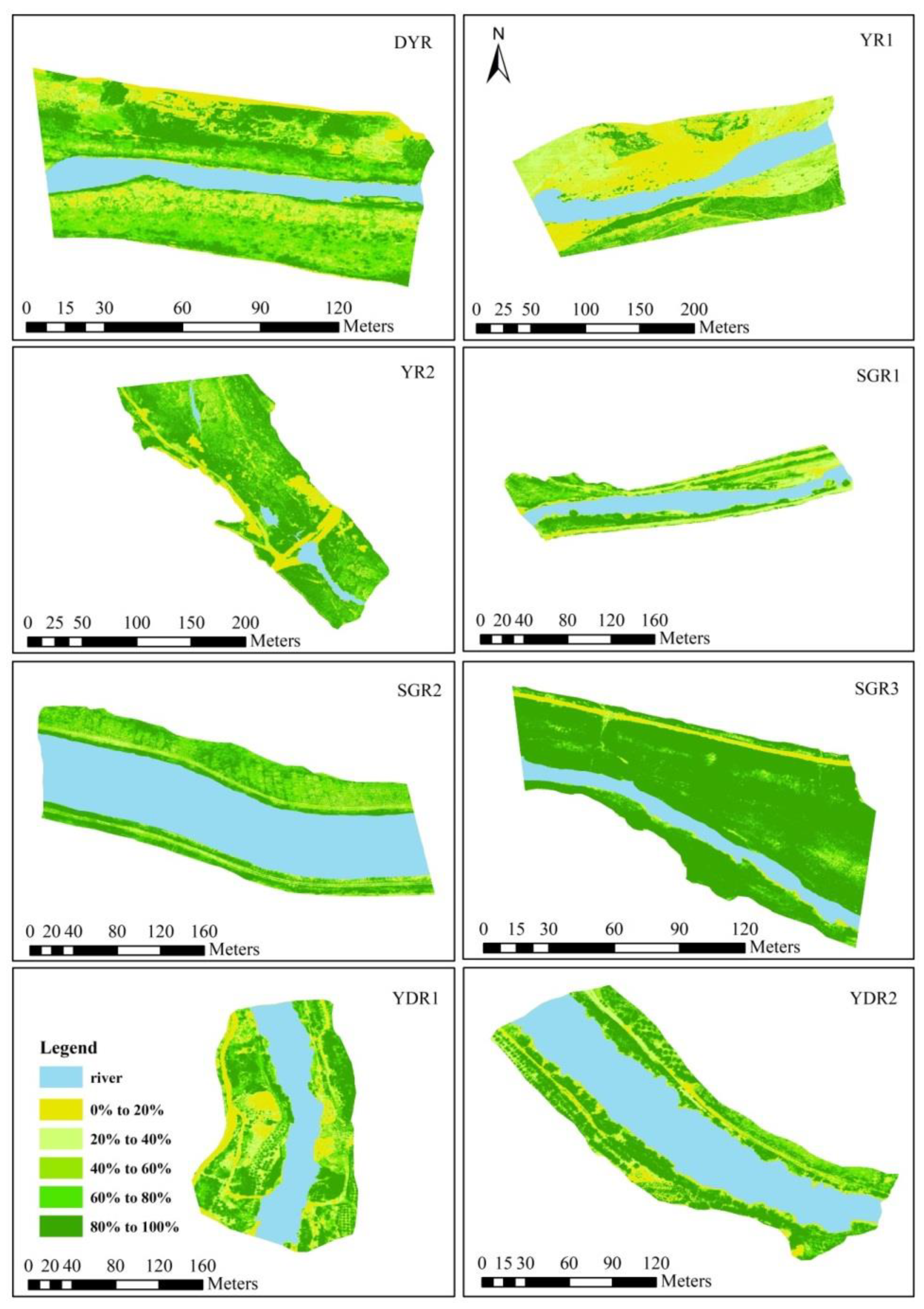
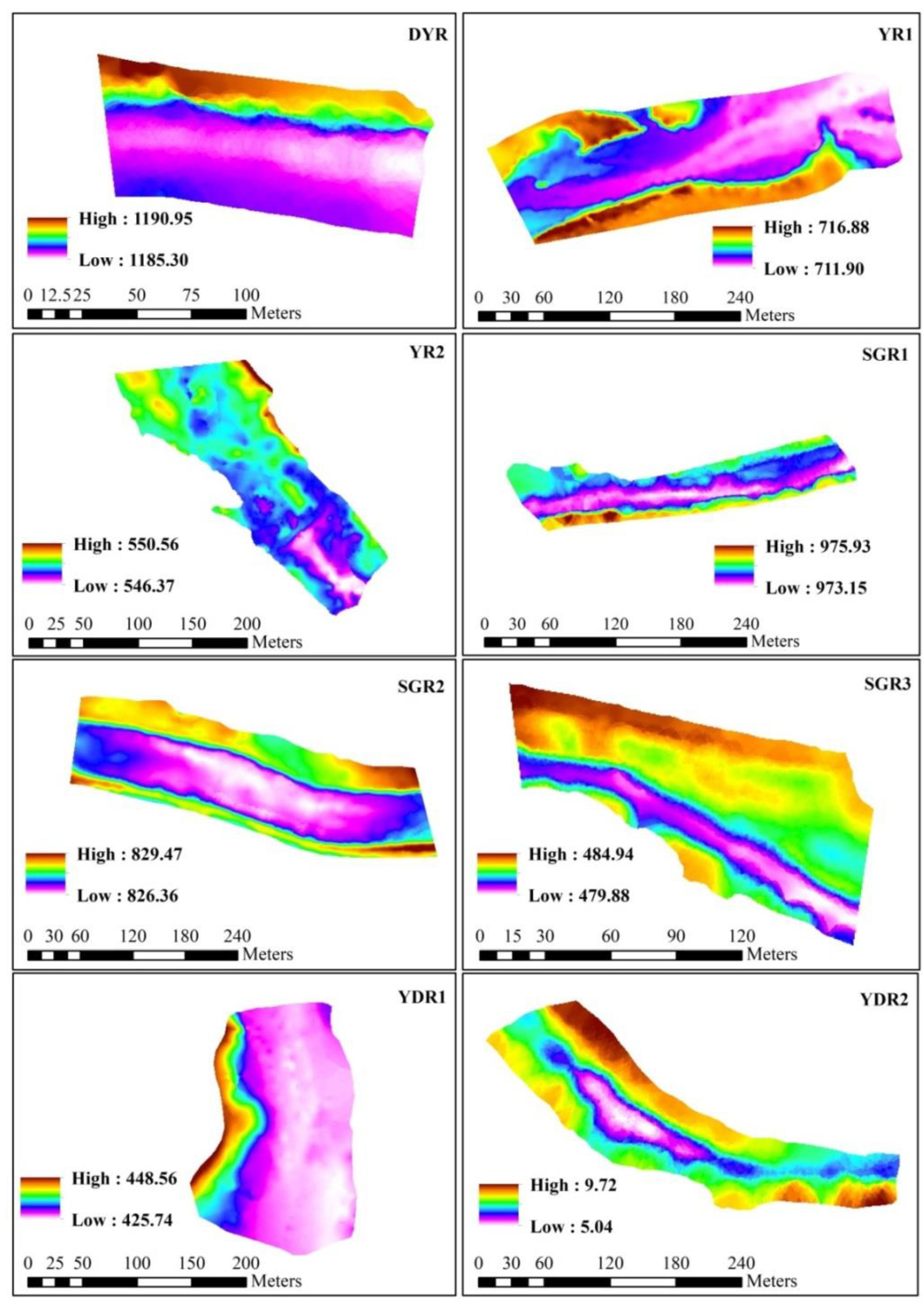
| Name | Center Wavelength | Bandwidth | |
|---|---|---|---|
| 1 | Blue | 465 nm | 32 nm |
| 2 | Green | 560 nm | 27 nm |
| 3 | Red | 668 nm | 16 nm |
| 4 | Red edge | 717 nm | 12 nm |
| 5 | Near-infrared | 842 nm | 57 nm |
| 6 | Thermal | 11 μm | 6 μm |
| DYR | YR1 | YR2 | SGR1 | SGR2 | SGR3 | YDR1 | YDR2 | |
|---|---|---|---|---|---|---|---|---|
| Extremely Low 0–20% | 12.0% | 37.4% | 14.4% | 10.3% | 0.6% | 3.6% | 17.4% | 10.5% |
| Low 20–40% | 10.7% | 28.4% | 5.4% | 24.5% | 9.2% | 1.6% | 15.3% | 10.9% |
| Medium 40–60% | 20.9% | 10.2% | 10.1% | 15.0% | 23.4% | 2.9% | 13.1% | 12.3% |
| High 60–80% | 27.1% | 7.5% | 22.0% | 17.3% | 26.9% | 6.8% | 17.5% | 15.2% |
| Extremely High 80–100% | 29.3% | 16.5% | 48.1% | 32.9% | 39.9% | 85.1% | 36.7% | 51.1% |
Publisher’s Note: MDPI stays neutral with regard to jurisdictional claims in published maps and institutional affiliations. |
© 2020 by the authors. Licensee MDPI, Basel, Switzerland. This article is an open access article distributed under the terms and conditions of the Creative Commons Attribution (CC BY) license (http://creativecommons.org/licenses/by/4.0/).
Share and Cite
Ren, L.; Liu, Y.; Zhang, S.; Cheng, L.; Guo, Y.; Ding, A. Vegetation Properties in Human-Impacted Riparian Zones Based on Unmanned Aerial Vehicle (UAV) Imagery: An Analysis of River Reaches in the Yongding River Basin. Forests 2021, 12, 22. https://doi.org/10.3390/f12010022
Ren L, Liu Y, Zhang S, Cheng L, Guo Y, Ding A. Vegetation Properties in Human-Impacted Riparian Zones Based on Unmanned Aerial Vehicle (UAV) Imagery: An Analysis of River Reaches in the Yongding River Basin. Forests. 2021; 12(1):22. https://doi.org/10.3390/f12010022
Chicago/Turabian StyleRen, Liangsuo, Yadong Liu, Shurong Zhang, Lirong Cheng, Yujing Guo, and Aizhong Ding. 2021. "Vegetation Properties in Human-Impacted Riparian Zones Based on Unmanned Aerial Vehicle (UAV) Imagery: An Analysis of River Reaches in the Yongding River Basin" Forests 12, no. 1: 22. https://doi.org/10.3390/f12010022
APA StyleRen, L., Liu, Y., Zhang, S., Cheng, L., Guo, Y., & Ding, A. (2021). Vegetation Properties in Human-Impacted Riparian Zones Based on Unmanned Aerial Vehicle (UAV) Imagery: An Analysis of River Reaches in the Yongding River Basin. Forests, 12(1), 22. https://doi.org/10.3390/f12010022





